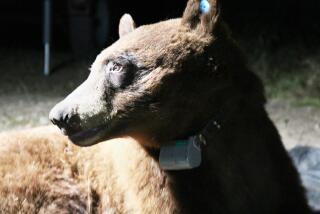San Diego Zoo polar bear Tatqiq wears a collar for research
- Share via
Tatqiq, a polar bear at the San Diego Zoo, is part of a research project aimed at finding ways to arrest the sharp decline of her species in the wild due to global warming.
For several hours each day recently, the 14-year-old, 520-pound female has been wearing a collar that transmits data tracking her movements.
At the same time, a researcher from the U.S. Geological Survey is filming Tatqiq as she walks, eats, runs, rests and swims at the zoo’s Polar Bear Plunge.
By comparing the film with the tracking data, researchers can figure out what Tatqiq was doing when certain data – think squiggly lines like an EKG readout – was transmitted from a small, battery-operated accelerometer around her neck.
From those conclusions, researchers will be able to gauge what polar bears in the wild were doing when similar data were being transmitted from their collars, which were slipped on while they were tranquilized. Because of the remoteness and bitter temperature of the Arctic, long-term watching of polar bears is not practical.
The goal of working with Tatqiq – and a polar bear at the zoo in Portland, Ore. – is “to get a sense of their energy demands,” said USGS research wildlife biologist Anthony Pagano. He leaves San Diego on Tuesday to return to the USGS outpost in Anchorage.
Tatqiq was chosen because the zoo’s other polar bears – the female Chinook, 20, and Tatqiq’s brother Kalluk, 14, - are in the middle of mating season. As Kalluk’s sister, Tatqiq is not a breeding candidate for genetic reasons. During breeding season, she is on chemical birth control.
To many conservationists, the polar bear is the symbol of the worst effect of global warming.
A study by several groups, including the USGS, concluded that the bear population in the southern Beaufort Sea, for example, had declined from 1,600 in 2004 to about 900 by 2010, with the downward trend likely to continue.
“Global warming is happening now and killing polar bears now,” Sarah Uhlemann, senior attorney for the Center for Biological Diversity, told The Times when the report was issued in November.
As the amount of sea ice has shrunk, polar bears have been forced to make long swims to find new ice and the seals that are the bears’ principle diet. Many bears lack the energy; the long swims may also imperil the females’ ability to deliver healthy cubs.
In San Diego, the project to gather film and accelerometer data is being done in cooperation with the zoo’s Institute for Conservation Research. (Tatqiq is brownish because she rolls in the dirt, not the snow and ice of the Arctic region, keepers say.)
Getting Tatqiq ready for the collar, which weighs about 2.5 pounds, took several weeks. During her breakfast feeding, a lighter-weight “practice collar” was slipped around her neck by keepers safely outside iron bars.
But when the day for the actual collar arrived, a glitch occurred.
The collar had been used on other bears and Tatqiq smelled their presence and was not happy. The new collar needed to be “washed” with dirt and sprayed with some of Tatqiq’s urine before she was comfortable.
Tatqiq’s personality is a mixture of cooperation and assertiveness. She was docile during a recent exam when veterinarians feared she might have cancer (she didn’t). But she can be grouchy when not fed quickly enough.
“She’s a good bear,” said senior polar bear keeper Matthew Price.
tony.perry@latimes.com
More to Read
Sign up for Essential California
The most important California stories and recommendations in your inbox every morning.
You may occasionally receive promotional content from the Los Angeles Times.










